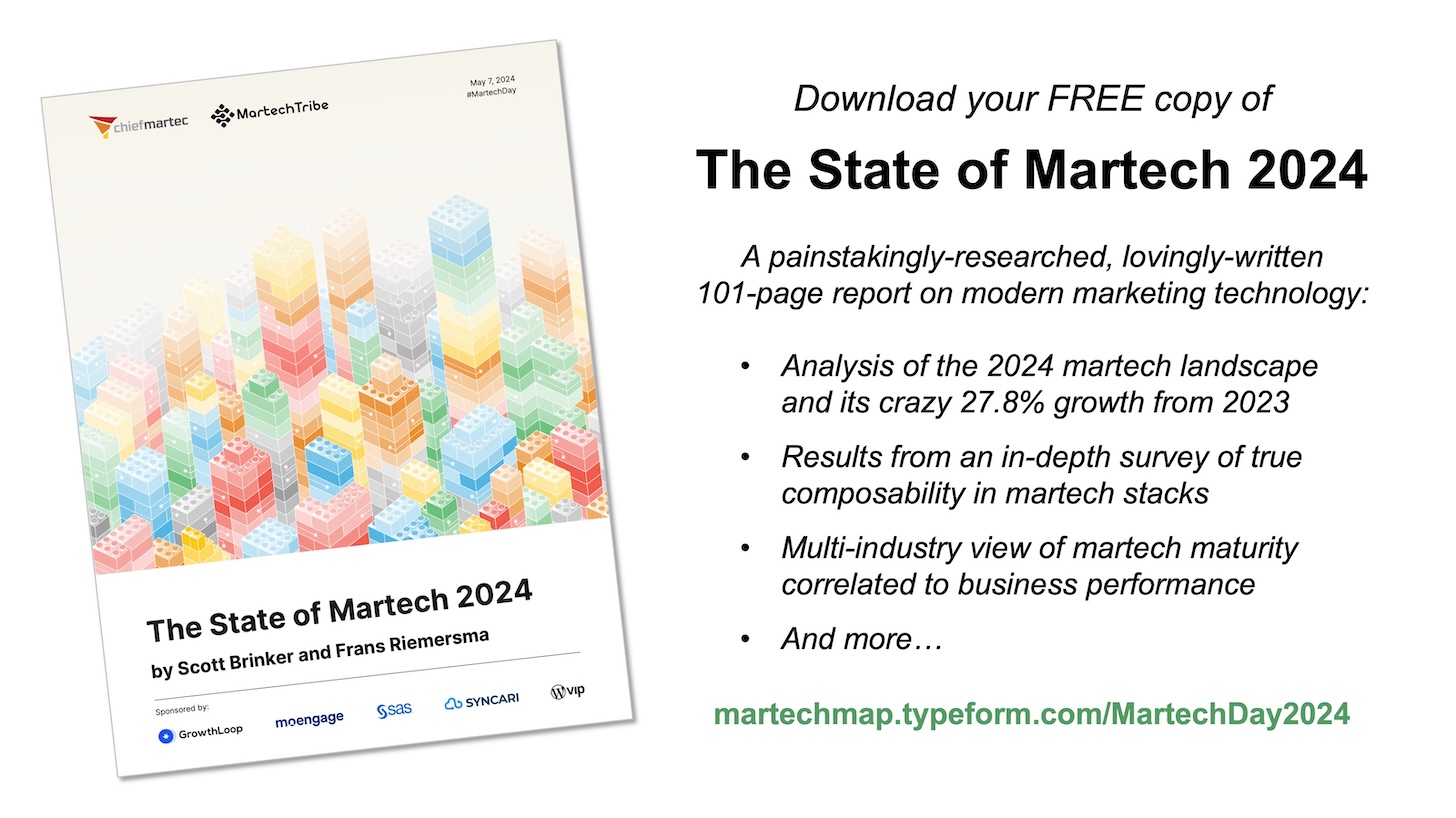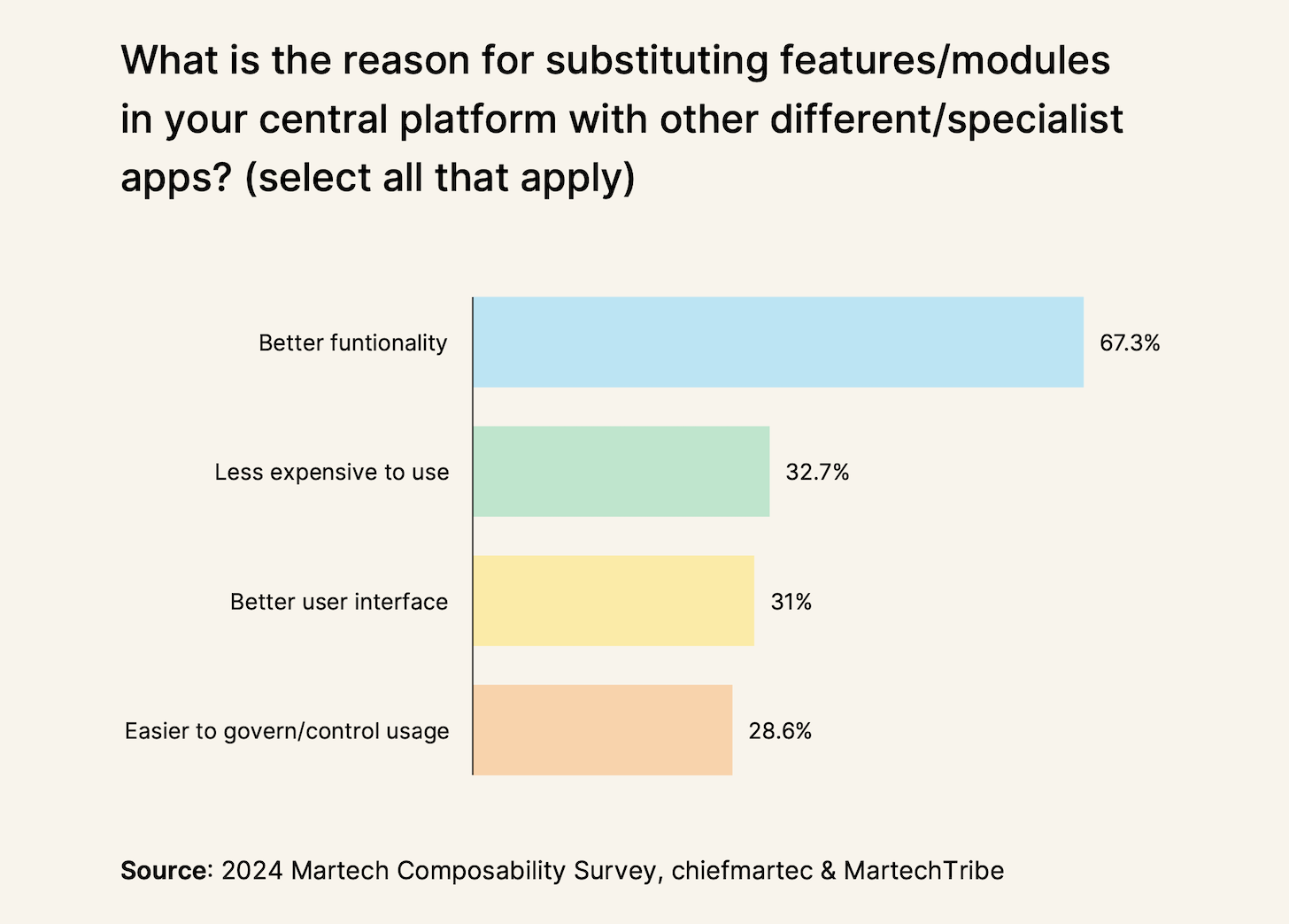
For years, the conventional wisdom in martech has been: the fewer apps in your stack, the better. It’s obvious, right? By reducing the number of apps, you will save money, have a better user experience, and improve your governance control.
The CFO’s default answer to optimizing martech costs? Cut apps.
The CIO’s default answer to optimizing martech governance? Cut apps.
Seems rational. But what if it wasn’t necessarily true?
Last week, on #MartechDay (May 7), Frans Riemersma and I released the 2024 martech landscape, celebrated the 2024 Stackie Awards, and published a new 101-page report on The State of Martech 2024. (You can download a copy for free here.)
A key section of the report was the analysis of our recent study on composability in martech stacks, conducted with 168 martech and marketing ops professionals. We approached the subject with a broad view of composability: combining any set of things together to create a whole greater than the sum of its parts. Not just composable platforms. In our view, martech stacks themselves are composed of multiple products, integrated together.
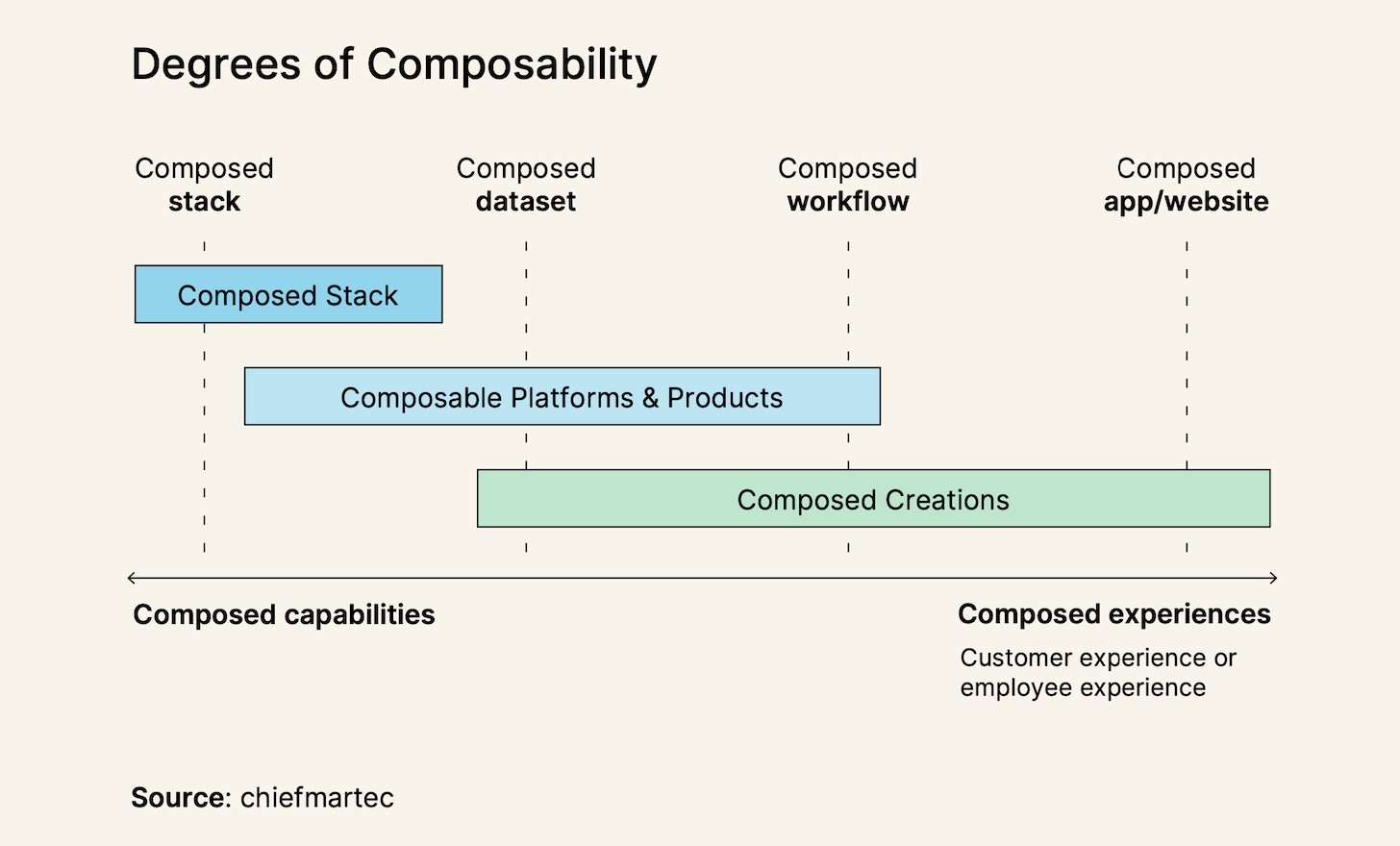
The results of this study were fascinating, with quite a few surprises. I can’t cover them all here — grab a free copy of the report for the full shebang — but I want to talk about by far the most counterintuitive and controversial.
The axiom of “less is more” in martech stacks isn’t always true.
First, let’s set the context. Everyone who participated in our study identified a platform that they considered to be the “center” of their stack. 32.1% said it was a CRM, 26.2% a MAP or CEP, 15.5% a CDP, and — a topic for another day — 12.5% a data warehouse.
What made a platform the “center” of one’s martech stack? The fact that most of the other products in their stack were integrated to it.
Now, almost all of these platforms have a wide range of features included or available as add-on modules or products in their larger suite. This is the result of consolidation in the martech industry as people typically think of it: large martech companies absorb a number of capabilities, either through M&A or by organically building them over time.
“Great!” most people say. “So we need fewer other apps.”
Other things being equal, yes. But other things aren’t always equal.
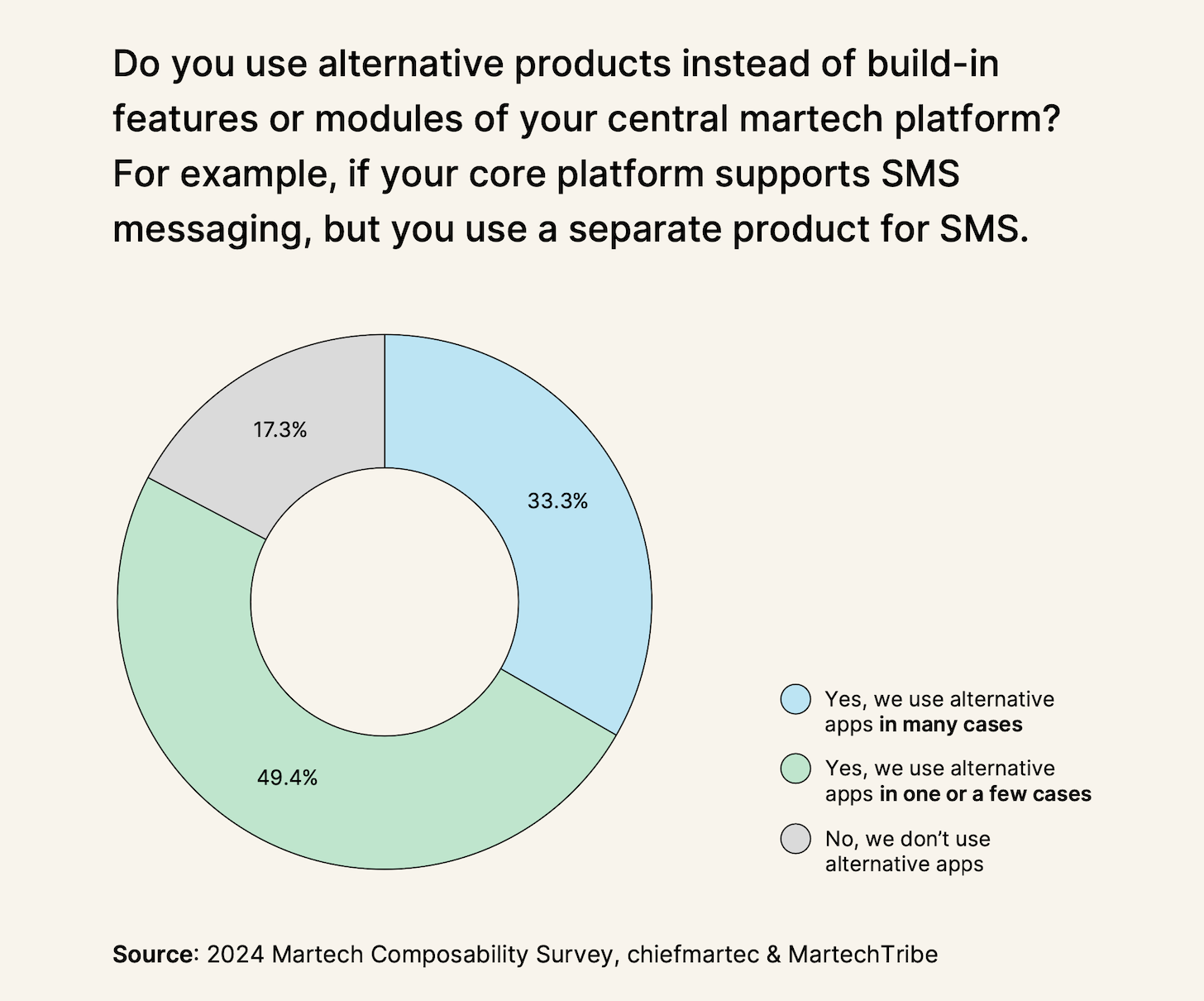
In fact, even though a particular feature is available in that primary platform, 82.7% of respondents admitted that they instead choose alternate products for some of their use cases. A full third (33.3%) said they adopt alternate products for many use cases.
“Why the hell would they do that?” you might wonder.
That’s the exact question we had. And the chart at the top of this article gives you the answers (respondents could choose more than one):
- 67.3% said the alternate apps offered better functionality
- 32.7% said the alternate apps were less expensive to use
- 31.0% said the alternate apps had a better user interface
- 28.6% said the alternate apps were easier to govern and control
In other words, these weren’t mistakes. They didn’t accidentally duplicate features across two different products. They consciously chose to use an alternate or specialist app for very rational reasons.
Let’s examine each of those reasons in more detail.
Specialist Martech Apps for Better Functionality

The most common reason? Better functionality. Or, perhaps more generously: different variations of that functionality that happen to be better for their particular preferences and use cases.
Just because a product can check the box and say it does X, doesn’t mean that the way it does X addresses all the specific needs and use cases that a marketer has in mind.
The example we gave in the question — SMS messaging — is a good one. How do you construct the SMS campaigns? Approve them? Queue them? Personalize them? Segment audiences for them? Deploy them in sequences? Manage replies? Track results? Trigger next steps? Alert exceptions? A/B test alternatives? And so on. You can imagine a myriad of different ways all of this could work under the generic label of “SMS messaging.”
Not every marketer is going to want it to work the same way. They may only need or want a subset of those capabilities. Some of them might require much more advanced features than others. It’s almost impossible for any one product to do all of these things the exact way every marketer on the planet would ideally want them to work.
And, hey, that’s okay. That’s what open platforms in martech are for. Baseline functionality in the primary platform may serve most of the needs, for most marketers, most of the time. But when a marketer needs something different, they have the option to adopt an alternate app that integrates with that platform to deliver more specialized capabilities.
This is a win for the marketer. But frankly, it’s also a win for the platform. They remain the “center” of the stack by enabling the marketer to incorporate any of the more specialized functionality they require into their operations. Value creation is not a zero-sum game. In platform ecosystems, it’s actually a team sport.
A couple of other common examples: creative tools and analytics. A lot of major martech platforms — especially those that serve as an engagement layer with customers — include some creative capabilities, such as to build emails or landing pages. And almost every martech platform includes some analytics capabilities of their own. Yet few of them come close to the functionality you get from dedicated creative tools or dedicated business intelligence platforms. Very common to see substitute specialist apps in these categories.
But honestly, this reason of “better functionality” as a motivation for using alternate apps wasn’t terribly surprising. I had assumed that people chose to substitute in specialized apps because they needed certainly functionality that wasn’t covered by the implementation in their primary platform.
The next three reasons were more surprising though.
Specialist Martech Apps for Better Economics

This was probably, at least on the surface, the most counterintuitive finding: in a third of the cases (32.7%), people chose to substitute features/modules in their primary platform with a separate, specialist app because it was less expensive.
So, buying more martech apps is actually a way to save money?
Paging Stranger Things. We’ve found another portal to the Upside Down.
Or so it would seem at first blush. But once you think about it, you realize that there are a number of ways in which this can be true without creating a space-time paradox.
Add-on or tier costs. The functionality might not be included in your current contract or plan on the platform. It might be an additional module or add-on that you need to purchase. Or it might require you to upgrade from your current tier to a higher one, which could ripple across your seat licenses. In these cases, it’s legit to compare that price increase against the cost of an independent alternative app.
Usage costs and transaction fees. Some martech activities lend themselves to being metered with variable costs — data storage, records, email or SMS messages, bandwidth, transaction fees, call volume, generative AI “credits”, etc. A specialist app may have more favorable usage pricing than your primary platform for some of these activities.
Externality costs. Depending on the configuration of your overall tech stack, contractual obligations you have with service providers, other system dependencies, internal process requirements, or even resource and talent availability, the “all in” total cost of deploying a capability with a specialist app may be cheaper than implementing it on your primary platform.
However, be careful there. Externalities can cut both ways. If you calculate the Total Cost of Ownership (TCO) for any new capability that you want to add to your martech stack, you may find that a slightly higher price in subscription costs or usage costs on your primary platform is worth it, given the externalities generated from bringing in an independent specialist app.
The point is that the economics of a given martech capability may favor either your primary platform or a specialist app depending on the specific circumstances. You have to do the math.
Specialist Martech Apps for Better User Experience

I’m an advocate of tech stack aggregation, which is different from consolidation. You can aggregate apps horizontally at data, workflow, UX, or governance layers.
With UX layer aggregation, I subscribe to the premise — other things being equal — that keeping a user in a single UI, in a single browser tab, is the best way to optimize their work experience. It shortens learning curves. It reduces context switching, which is an expensive mental tax. It helps users stay in the flow.
Of course, as you’ve probably guessed: other things aren’t always equal.
In 31% of the cases of marketers substituting an alternate app for a given capability in their primary platform, they did so because the app provides a better user interface.
While consistency is one factor in user experience, it is not the only factor. Specialist apps have the freedom to design a UI crafted specifically for the functionality at which they excel. It might be simpler, removing all other distractions from the core capability it serves. Or it might be more complex, offering far more features and flexibility for experts or power users. But above all, it’s built with one, clear purpose in mind. Every facet of its UX can be tailored to that mission.
These specialist apps are often best suited to “deep work”, where a user gets absorbed in a particular activity for a period of time. Context switching is minimal because they prefer to focus while working on it anyway. They stay in context.
Creative tools are often a great example of this. The experience of using Riverside.fm to record a podcast or webinar. The experience of using Descript to edit that recording. The experience of using Canva to create promotional assets for the show. These are best-in-class user experiences. They couldn’t be homogenized without losing the essence of what makes them so remarkable.
Specialist Martech Apps for Better Governance

Finally, 28.6% of respondents said that they used one or more alternative/specialist apps because they were easier to govern or control usage.
This too, by conventional wisdom, seems counterintuitive. Isn’t one of the major problems of stack sprawl is that it’s difficult to govern all these different apps? Who has permissions to do what in which app? Are these apps compliant? Are they secure? Do they live up to their expected SLAs?
Other things being equal, fewer apps are easier to govern.
But again — wait for it — other things aren’t always equal. Two examples of this.
First, as with a purpose-built user experience, a specialist app might have a bespoke set of permissions it can assign to users designed around its particular mission. The granularity of what a user can and can’t do, or the workflow of collaborations, reviews, approvals, etc., can be crafted especially for the kinds of work and team interactions being done in this app.
Second, working in a separate, stand-alone app can provide a safe “sandbox” environment for certain kinds of work. An individual or a team can be given access to this app without having to be given greater access in the primary platform.
This can be a useful pattern for experimenting with emerging capabilities. If you want to try something new, quickly, on a small scale, just to learn about it and see if it works, it may be simpler to initially do that an in a separate app. It saves the overhead of mapping out all the permissions and workflows that would be required to fully incorporate it into your primary platform.
Now, it’s important to emphasize that this is not “shadow IT.” These independent specialist apps should be vetted and visible. They are an official part of your tech stack. They can — and should — be connected to governance layer aggregation platforms, such as identity and access management for single sign-on, SaaS management platforms for consistent onboarding and offboarding, and data privacy software for compliance monitoring.
More Specialist Apps, More Counterintuitive Benefits
By the way, the more alternative apps that marketers use to substitute features/modules in their primary platform, the more likely they are to cite better functionality (82.1%), better economics (44.6%), better user experience (42.9%), and better governance (35.7%) as reasons for doing so:
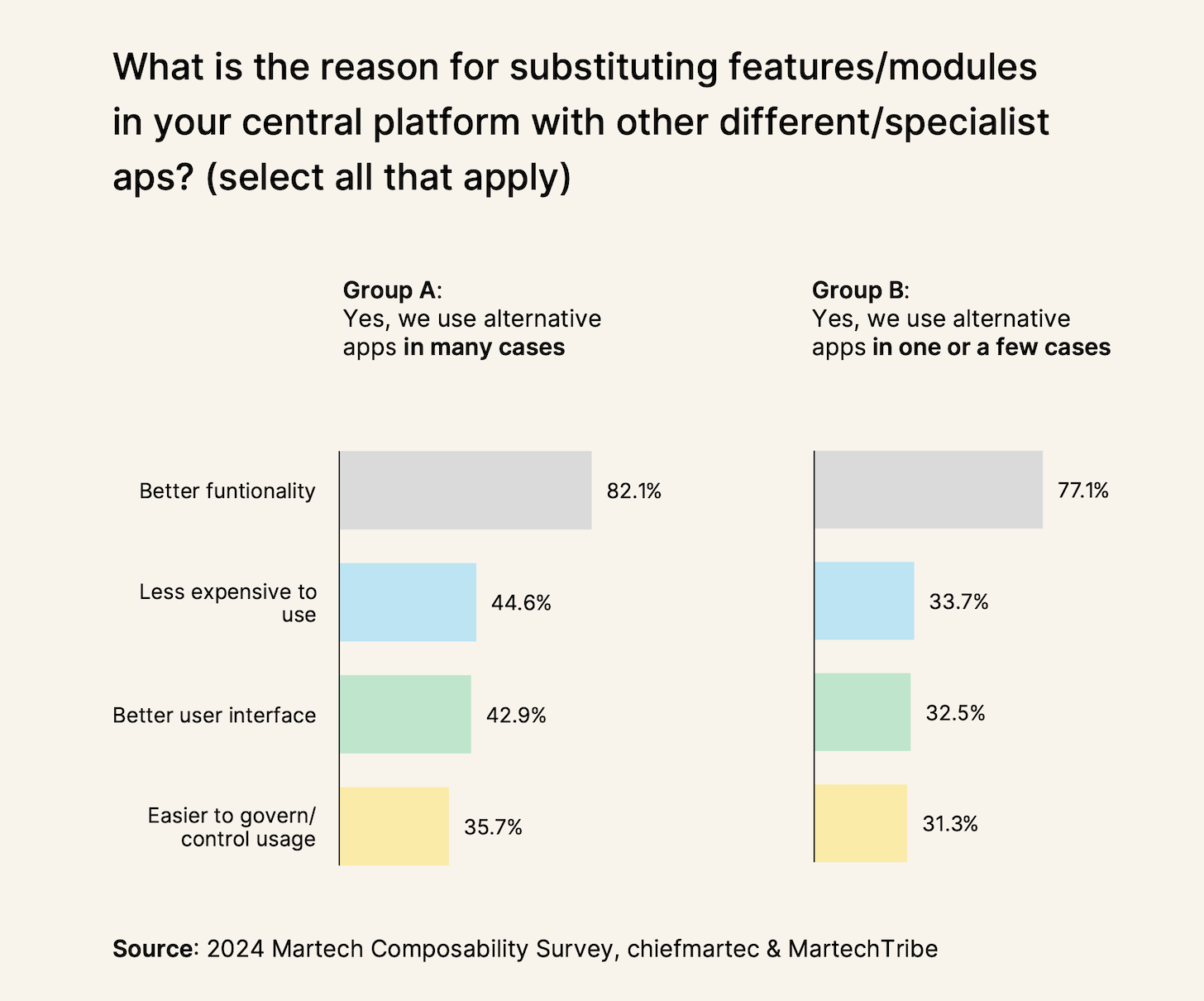
Is this because the more alternative apps they use, the better they get at extracting these substitute value adds? Or because they recognize more value-add substitution scenarios for their business and then choose to adopt them? Probably both.
However, I want to stress that the conventional wisdom of “less is more” isn’t entirely wrong. I am still a proponent of Martec’s Razor (a cheap knock-off of Occam’s Razor): other things being equal, the simplest stack is best.
But as the data shows… Other things. Aren’t. Always. Equal.
For more surprising martech findings and analyses, pick up a copy of our 101-page The State of Martech 2024 Report. You can register for a free copy to be emailed to you here. (Thank you again to our sponsors: GrowthLoop, MoEngage, SAS, Syncari, and WordPress VIP.)
